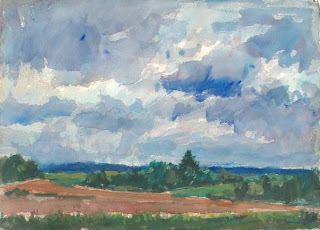EUGENE LEAKE: WORKS ON PAPER
October 22 – November 29, 2008
Grimaldis Gallery
Essay By Craig Hankin
In 1991, photographer Bill McAllen snapped a picture of Eugene Leake in the midst of a fog-shrouded field at dawn. What was unusual about this image, apart from the rose-tinged veils of mist, was that it depicted the 80-year-old Leake seated in a battered, metal folding chair, drawing.
I had known Leake for 17 years at that point. He was my close friend and mentor. We’d spent a considerable number of hours together, talking and painting. But I had never seen him sit down and draw. McAllen’s photograph surprised me, revealing a side of my friend I hadn’t encountered before.
When the Baltimore Museum of Art and the Grimaldis Gallery exhibited selected works on paper in 1994, it came as a revelation to most of Leake’s admirers. I felt a similar thrill recently upon seeing several of the pieces in the current show for the first time.

At his death in 2005, Leake’s reputation as a clear-eyed, unsentimental painter of rural Maryland landscape was firmly established. He was well-known for his robust, thickly brushed oils on canvas. Far less familiar was the artist who created these vibrant and bracing watercolors. (Ironic, considering his first one-man show at New York’s Walker Gallery in 1937 consisted mainly of expressionistic watercolor landscapes.)
And yet we recognize the sure-handed attack, the immediacy of impression, and the lush, saturated color, even in this most delicate and unforgiving medium. Whether it’s the brooding, bruised clouds ready to drench the Irish countryside or an abandoned yellow tractor overgrown with weeds in a Wyoming meadow, the sensibility rings true.
It would be tempting to romanticize Leake, whose favorite painters were all born before the middle of the 19th century. It would also be a mistake. Like any artist worth his salt, Leake was a product of his times. He was seven years younger than de Kooning, four months older than Pollock, and painted abstractly for much of the 1950s. And he saw things Courbet and Monet never lived to see: color photography and movies, the Holocaust, the atom bomb, television, space exploration, global warming. While one might be hard-pressed to identify them in his work, these ideas, events and technologies informed and shaped the artist he became.

A man of some means, he lived simply. He could have lived anyplace; he chose the country. He chose nature. Though he could have traveled anywhere in the world to seek out subject matter, he was perfectly content to paint what he found within a few miles – or a few yards – of his Monkton farmhouse. (Without doubt, Leake’s transcription of the evanescent skies over the hillsides and glistening lakes of County Donegal in northwest Ireland, as majestic and timeless as a Claude Lorrain wash drawing, is one of the gems in this exhibition. But don’t assume for a minute that site meant more to him than the cobalt blues and greens of the pasture east of his property’s fence line or that black viridian stand of trees on Pocock Road, just around the bend.)

While we think of him primarily as a landscape painter, Leake also painted dozens of self-portraits in his lengthy career. A few are included in this show. You won’t find a better portrait of the artist, however, than the tiny sunrise, captured quickly with a few strokes of pale orange and transparent mauve. Here is the life well-lived, in Zen-like harmony and balance.
Thank you, old friend, for reminding us what we loved about your work in the first place and for continuing to surprise us after all these years.
Craig Hankin is a painter, writer and critic. He is the Director of the Homewood Art Workshops at Johns Hopkins University, where he has taught drawing and painting since 1980.





